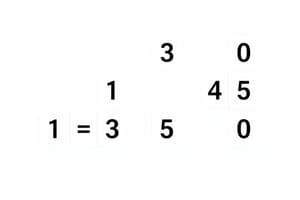Podcast
Questions and Answers
What is the initial configuration of the forest of trees in Huffman's algorithm?
What is the initial configuration of the forest of trees in Huffman's algorithm?
- A forest of trees, each with a weight equal to the frequency of a single character
- A forest of trees, each with a weight equal to the sum of the frequencies of all characters
- A forest of trees, one for each character (correct)
- A single tree with a weight equal to the sum of the frequencies of all characters
What is the goal of Huffman's algorithm?
What is the goal of Huffman's algorithm?
- To solve smaller problems recursively
- To find the optimal Divide and Conquer algorithm
- To find the optimal Huffman coding tree (correct)
- To form a new tree with a weight equal to the sum of the frequencies of its leaves
What is done with the two trees of smallest weight in Huffman's algorithm?
What is done with the two trees of smallest weight in Huffman's algorithm?
- They are solved recursively
- They are merged to form a new tree (correct)
- They are divided into smaller sub-problems
- They are discarded
What is the purpose of the Divide step in Divide and Conquer algorithm?
What is the purpose of the Divide step in Divide and Conquer algorithm?
What is the purpose of the Conquer step in Divide and Conquer algorithm?
What is the purpose of the Conquer step in Divide and Conquer algorithm?
How are ties broken when selecting the two trees of smallest weight in Huffman's algorithm?
How are ties broken when selecting the two trees of smallest weight in Huffman's algorithm?
What is the weight of a tree in Huffman's algorithm?
What is the weight of a tree in Huffman's algorithm?
What is the purpose of Huffman's algorithm?
What is the purpose of Huffman's algorithm?
How many trees are there at the beginning of Huffman's algorithm?
How many trees are there at the beginning of Huffman's algorithm?
What is the result of Huffman's algorithm?
What is the result of Huffman's algorithm?
Flashcards are hidden until you start studying
Study Notes
Sorting Algorithms
- Mergesort is a sorting algorithm that divides the input data into smaller parts, sorts them recursively, and then merges them into a single sorted list.
- The merging process involves comparing elements from two sorted arrays and combining them into a single sorted array.
- The algorithm continues until all parts are merged into a single sorted list.
Mergesort Algorithm
- The mergesort algorithm takes three parameters:
data,firstItem, andlastItem. - If
firstItemis less thanlastItem, the algorithm divides the data into two halves, recursively sorts each half, and then merges the two sorted halves.
Quicksort
- Quicksort is a fast sorting algorithm with an average running time of O(N log N) and a worst-case running time of O(N2).
- The algorithm works by selecting a pivot element, partitioning the list around the pivot, and then recursively sorting the sublists.
- The heap property ensures that the smallest element is stored in the root of the tree.
Implementation of Priority Queue
- A priority queue is a data structure that follows the heap-order property, where the parent node is either greater than or equal to its child nodes.
- Basic heap operations include inserting an element, deleting an element, and finding the minimum element.
- Inserting an element involves adding it to the end of the tree, moving the parent value into the empty slot, and bubbling the hole up until the parent is less than or equal to the new element.
- Deleting an element involves finding the minimum element, removing it, and then bubbling the hole down until the last element can be placed in the empty slot.
Sorting
- Sorting is the process of arranging a group of items into a defined order based on a particular criteria.
- External sorting algorithms are designed to handle very large inputs that cannot fit into memory.
- External sorting algorithms involve reading the input data from a file, sorting it into smaller chunks, and then merging the sorted chunks into a single sorted file.
External Sorting
- An example of external sorting is the Mergesort algorithm, which involves reading the input data, sorting it into smaller chunks, and then merging the sorted chunks into a single sorted file.
- A program in C++ can be used to illustrate the working of the algorithm.
Graph Algorithms
- A graph consists of nodes (vertices) and connections between them (edges).
- Graphs can be directed or undirected, and edges can be weighted or unweighted.
- Different types of graphs include directed graphs, undirected graphs, and weighted graphs.
Greedy Algorithms
- Greedy algorithms involve making the locally optimal choice at each step, hoping to find a global optimum solution.
- Examples of greedy algorithms include coin-changing, scheduling, and Huffman coding.
- Coin-changing involves making the exact change with the minimum number of coins, using the largest coin possible.
- Scheduling involves finding the best way to schedule jobs in order to minimize the average completion time.
Huffman Coding
- Huffman coding is a method of encoding data using a variable-length prefix code.
- The algorithm works by building a Huffman tree, where each leaf node represents a character, and the weight of each node is the sum of the frequencies of its leaves.
- The algorithm involves selecting the two trees of smallest weight, breaking ties arbitrarily, and forming a new tree with the two subtrees.
Divide and Conquer
- Divide and Conquer algorithms involve dividing a problem into smaller subproblems, solving each subproblem recursively, and then combining the solutions to the subproblems to form the solution to the original problem.
- The algorithm consists of two parts: divide and conquer.
Studying That Suits You
Use AI to generate personalized quizzes and flashcards to suit your learning preferences.





